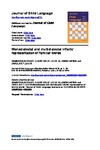Monodialectal and multidialectal infants’ representation of familiar words
| dc.contributor.author | Durrant, S | |
| dc.contributor.author | Delle Luche, C | |
| dc.contributor.author | Cattani, Allegra | |
| dc.contributor.author | Floccia, Caroline | |
| dc.date.accessioned | 2015-06-22T12:19:47Z | |
| dc.date.available | 2015-06-22T12:19:47Z | |
| dc.date.issued | 2014-03-21 | |
| dc.identifier.issn | 0305-0009 | |
| dc.identifier.issn | 1469-7602 | |
| dc.identifier.uri | http://hdl.handle.net/10026.1/3379 | |
| dc.description.abstract |
Monolingual infants are typically studied as a homogenous group and compared to bilingual infants. This study looks further into two subgroups of monolingual infants, monodialectal and multidialectal, to identify the effects of dialect-related variation on the phonological representation of words. Using an Intermodal Preferential Looking task, the detection of mispronunciations in familiar words was compared in infants aged 1;8; exposed to consistent (monodialectal) or variable (multidialectal) pronunciations of words in their daily input. Only monodialectal infants detected the mispronunciations whereas multidialectal infants looked longer at the target following naming whether the label was correctly produced or not. This suggests that variable phonological input in the form of dialect variation impacts the degree of specificity of lexical representations in early infancy. | |
| dc.format.extent | 447-465 | |
| dc.format.medium | Print-Electronic | |
| dc.language | English | |
| dc.language.iso | English | |
| dc.publisher | Cambridge University Press | |
| dc.subject | Female | |
| dc.subject | Humans | |
| dc.subject | Infant | |
| dc.subject | Language | |
| dc.subject | Language Development | |
| dc.subject | Male | |
| dc.subject | Multilingualism | |
| dc.subject | Recognition, Psychology | |
| dc.subject | Speech Perception | |
| dc.subject | Vocabulary | |
| dc.title | Monodialectal and multidialectal infants’ representation of familiar words | |
| dc.type | journal-article | |
| dc.type | Article | |
| plymouth.author-url | https://www.webofscience.com/api/gateway?GWVersion=2&SrcApp=PARTNER_APP&SrcAuth=LinksAMR&KeyUT=WOS:000349533200016&DestLinkType=FullRecord&DestApp=ALL_WOS&UsrCustomerID=11bb513d99f797142bcfeffcc58ea008 | |
| plymouth.issue | 2 | |
| plymouth.volume | 42 | |
| plymouth.publication-status | Published | |
| plymouth.journal | Journal of Child Language | |
| dc.identifier.doi | 10.1017/S0305000914000063 | |
| plymouth.organisational-group | /Plymouth | |
| plymouth.organisational-group | /Plymouth/Faculty of Health | |
| plymouth.organisational-group | /Plymouth/Faculty of Health/School of Psychology | |
| plymouth.organisational-group | /Plymouth/REF 2021 Researchers by UoA | |
| plymouth.organisational-group | /Plymouth/REF 2021 Researchers by UoA/UoA04 Psychology, Psychiatry and Neuroscience | |
| plymouth.organisational-group | /Plymouth/REF 2021 Researchers by UoA/UoA04 Psychology, Psychiatry and Neuroscience/UoA04 REF peer reviewers | |
| plymouth.organisational-group | /Plymouth/Research Groups | |
| plymouth.organisational-group | /Plymouth/Research Groups/Centre for Brain, Cognition and Behaviour (CBCB) | |
| plymouth.organisational-group | /Plymouth/Research Groups/Centre for Brain, Cognition and Behaviour (CBCB)/Cognition | |
| plymouth.organisational-group | /Plymouth/Research Groups/Plymouth Institute of Health and Care Research (PIHR) | |
| plymouth.organisational-group | /Plymouth/Users by role | |
| plymouth.organisational-group | /Plymouth/Users by role/Academics | |
| dc.publisher.place | England | |
| dc.identifier.eissn | 1469-7602 | |
| dc.rights.embargoperiod | Not known | |
| rioxxterms.funder | Economic and Social Research Council | |
| rioxxterms.identifier.project | Phonological representations in bidialectal listeners | |
| rioxxterms.versionofrecord | 10.1017/S0305000914000063 | |
| rioxxterms.licenseref.uri | http://www.rioxx.net/licenses/all-rights-reserved | |
| rioxxterms.type | Journal Article/Review | |
| plymouth.funder | Phonological representations in bidialectal listeners::Economic and Social Research Council |


